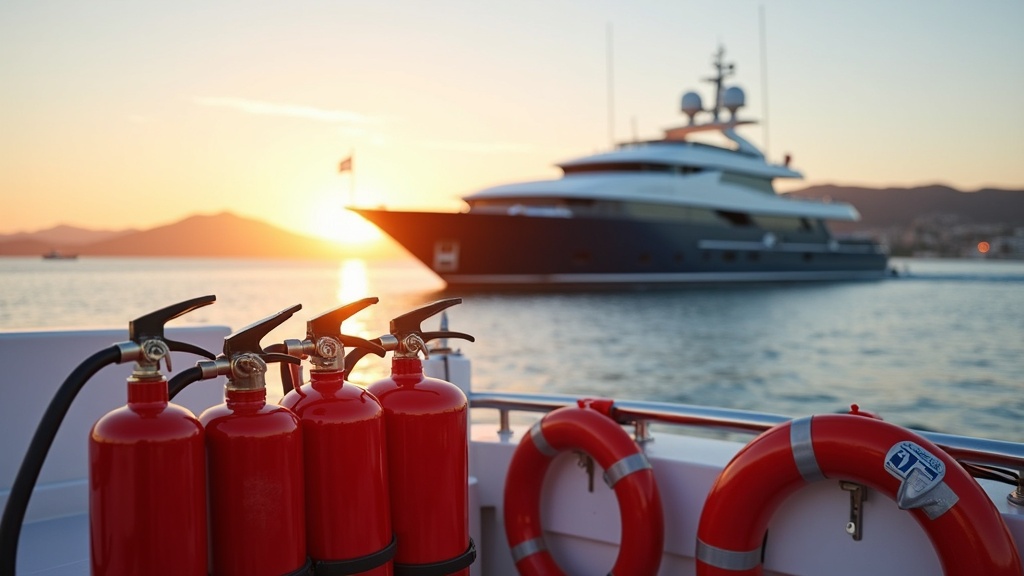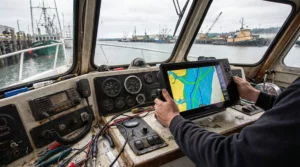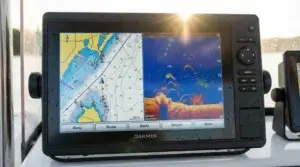Fire hazards on a yacht can pose unique challenges, threatening not just property but the safety and peace of everyone on board.
Confined spaces, limited exits, and the ocean’s isolation can turn even small fires into dangerous situations because help may take extra time to arrive. Understanding how to prevent yacht fires is crucial for protecting both lives and vessels alike. In this guide, I’ll walk you through proven safety habits, practical gear updates, real-world lessons, and easy actions you can put to work for a safer adventure.
Understanding Fire Hazards on Yachts
The first step in fire safety is to get a sense of what puts yachts at risk. Electrical problems, fuel leaks, accidents in the galley, and careless smoking are all common causes. What makes yacht fires even more concerning is how the materials used in construction, like fiberglass and wooden paneling, let fires spread fast. Since everything is more cramped aboard, it’s harder to escape quickly, making early awareness and prevention that much more important.
Experts point out that almost all yacht fires come from preventable causes. For example, BoatUS Marine Insurance shares that over half of all boat fire claims are caused by electrical issues. Adopting daily fire hazard-reducing habits is a practical and effective approach for every yacht owner.
Daily Fire Prevention Habits
The small decisions made each day aboard the yacht truly add up to better safety. Developing fire-smart routines becomes a foundation for preventing problems before they start. Here are a few steps to build into your daily routine:
- Unplug Appliances: Always turn off and unplug appliances and electronics when not in use, especially in the galley or cabins where many devices congregate.
- Don’t Overload Outlets: Keep electrical loads reasonable. Plugging too many items into outlets, especially when wet, raises fire risk.
- Avoid Open Flames: Never leave candles or portable grills unattended. Assign extra supervision anytime they’re lit, even if stepping away briefly.
- Smoker Safety: If guests smoke, set up a designated safe space well away from anything flammable, and make sure smoking materials are out cold before tossing them out.
With time, these habits become second nature, raising everyone’s awareness and forming a core part of a fire-safe approach onboard.
Fire-Safe Design and Yacht Equipment
The right yacht equipment, combined with thoughtful safety updates, helps bring fire risk down. While many modern boatyards focus on flame-resistant features and smarter layouts, even older yachts can be given a boost. Making a few upgrades, and choosing quality materials, sets you up for smarter fire protection.
Key Features for Fire Protection
- Fireresistant Panels: Adding panels and padding that take longer to burn gives valuable extra time should an emergency pop up.
- Protected Wiring: Insist on marine-rated wiring and circuit breakers. Avoid use of fuses in critical circuits—they can be slow and less reliable than circuit breakers.
- Stove Guards: Barriers and automatic shut-off features for the galley are a smart upgrade. These help stop accidental fires while cooking and cut risks from overturned pans or knocked-over items.
Essential Fire Safety Equipment
- Fire Extinguishers: Place the right extinguishers—such as a blend of dry powder and foam—at key locations for fast access. Don’t allow them to become buried or blocked by gear.
- Smoke and Carbon Monoxide Alarms: Install alarms wherever people sleep, as well as in the galley and engine room, so that fires or fume build-up are caught early, even overnight.
- Automatic Fire Suppression Systems: Especially in enclosed spaces like engine compartments, install automated fire suppression that triggers when temperatures spike unexpectedly.
If you purchase a used yacht, check—and if needed, upgrade—every item of fire safety gear right away. Thorough safety checks and a few hundred dollars in upgrades buy significant extra security for yacht and crew.
Electrical Systems: Maintenance and Inspection
Electrical problems are a leading root cause of fires onboard. Make a habit of thorough and regular electrical upkeep to keep risk as low as possible.
- Routine Checks: Inspect batteries, connections, and breaker panels for loose ends or corrosion. Check water-tightness of connections as well.
- Circuit Testing: Use a multimeter to track down current levels, spots of heat, or subtle leaks indicating deeper issues.
- Replace Old Equipment: Remove anything past its prime or not rated for marine use. Always upgrade to approved, modern components.
- Call the Experts: If in doubt, don’t hesitate to ask a certified marine electrician for help with complex wiring, alternators, or generators.
Frequent cleaning, organized record-keeping, and sticking to a regular inspection schedule mean that minor problems don’t turn into disasters. A little attention goes a long way.
Galley Precautions: Cooking Without Danger
The galley is a hotspot for fire incidents at sea. By putting a few precautionary steps in place, you can cook comfortably and safely every time you prepare a meal onboard.
- Supervised Cooking: Never leave the galley with an active stove, oven, or grill. Keep distractions to a minimum while using heat sources.
- Shut Off Gas Supply: Always close the main propane valve after use—never just the appliance control. This habit removes a hidden ignition source.
- Install Heat Sensors: Automatic shut-off sensors can save the day by cutting off heat if pots tip or if temperatures spike too high.
- Fire Blanket on Hand: Hang a fire blanket in the galley within easy arm’s reach to smother small oil or food fires right away.
For oil-heavy recipes or high-heat cooking, extra caution is wise. Stay cool, and have a plan to act quickly in case flames show up.
Fuel Safety: Handling and Storage
Every yacht uses fuel, making safe storage and handling a basic necessity. Small mishaps with gasoline or diesel can quickly escalate, so stay alert and use common sense whenever fuel is part of the routine.
- Check Hoses and Tanks: Give every fuel hose, tank, and connection a once-over every couple of months. Look for leaks, cracks, or worn areas.
- Keep Spaces Ventilated: Before powering up engines—especially after refueling or repairs—use blowers to move fumes out. Five minutes suffices for most engine rooms.
- Safe Fuel Storage: Put portable fuel containers in safe, secured places away from sources of heat or sparks. Never stow fuel near batteries or the engine.
- Quick Clean-Up: Cleaning up spills right away, with oil-absorbent pads and plenty of fresh air flow, helps prevent fires before they start.
Proper fuel management isn’t just sensible—it’s a must for safety at sea.
Ventilation and Engine Room Safety
Below deck, heat and fumes can build up. Ensuring regular air flow and monitoring the engine compartment are essential for fire prevention and a healthy onboard environment.
- Airing Out Regularly: After using engines or generators, open hatches and run fans to push stale air out and bring fresh air in.
- Check Vent Systems: Examine all air intake and exhaust pathways for dust, dirt, or blockages every trip.
- Temperature Alarms: Mount a simple alarm that will beep if heat levels climb unexpectedly in the engine room, giving an early heads-up before a crisis develops.
Simple checks and solid habits around ventilation can be the difference between routine operations and a preventable emergency.
Crew Training and Fire Drills
All the right equipment won’t help unless your crew and guests know exactly what to do. Regular drills and safety talks mean everyone is ready to jump into action if needed.
- Fire Response Plan: Before embarking, review the escape routes, location of extinguishers, alarms, and muster points.
- Fire Drills: Every few trips, simulate a fire scenario. Use a stopwatch—see how fast everyone can gear up and get to muster points.
- Assign Roles: For longer journeys or with more people, spell out who handles radio calls, fights the fire, or manages the life raft. Clarity saves precious time.
Confidence and quick reactions start with practice. Even if you never face an emergency, those drills reduce panic, keep everyone sharp, and could make all the difference someday.
Common Questions About Yacht Fire Safety
Fire risk raises plenty of questions. Here are three of the most common, with direct, experience-backed answers.
Question: What type of extinguisher should I use on a yacht?
Answer: Always use marine-rated “ABC” extinguishers for yacht work. These handle liquid, electrical, and solid material fires and should be within easy reach, especially near potential trouble spots like the galley and engine room.
Question: How often should I check alarms?
Answer: Test all smoke and gas alarms twice a year at minimum. Replace batteries at the first sign of a warning chirp, regardless of any calendar schedule.
Question: Is it risky to leave devices plugged in?
Answer: Charging devices or having electronics plugged in overnight or when not around does raise fire risk due to possible circuit overloads or device failures. Unplug what you’re not using and stick to surge protection that’s specifically marine approved.
Real-World Examples: Lessons Learned
Many yacht fires hit the headlines every year—and nearly all are tied back to something that could have been handled differently. For example, a yacht anchored in Florida suffered severe damage when a corroded battery connection, surrounded by cleaning rags, sparked a fire. Thankfully, no one was hurt, but it hammered home the risks of leaving combustibles near power sources, and why you should give battery setups a close look regularly.
In another well-known case from the Mediterranean, a galley fire broke out after a towel was left too close to a warm stovetop. Fast crew action with a fire blanket prevented major loss. Both situations drive home the lesson that a moment’s carelessness can start a chain reaction, but practicing good habits and keeping the right tools close at hand will often stop a problem before it gets out of control.
Action List: How I Keep My Yacht Fire-Safe
- Inspect Electrical and Fuel Systems: Run through a checklist before every departure.
- Check Alarms and Extinguishers: Confirm everything is in working order and charged up.
- Practice Drills: Walk guests and crew through emergency plans every time a new trip begins.
- Secure Flammable Items: Place oils, cleaning products, backup fuel containers, and spare propane away from the engine or any heat source.
- Keep Ventilation Open: Regularly clear vents and keep air circulators running in tight spots below deck.
Making these steps part of my pre-trip routine protects both my adventure and the friends and family who come along for the ride. I always say—prevention isn’t a task on a list, but a regular, ongoing mindset. Reminding fellow yacht owners to treat fire safety as a habit only keeps everyone safer.
Protecting Your Yacht and People Onboard
Preventing fire hazards on a yacht goes well beyond simply checking boxes. It’s a lifestyle of regular habits, thoughtful equipment choices, and building a crew culture of awareness. Careful maintenance, up-to-date safety gear, and solid day-to-day routines make continued fun, safety, and peace of mind possible. Each small action adds up—protecting your investment and, more importantly, the lives of everyone enjoying the adventure. Taking fire safety seriously means more great days on the water, wrapped in the confidence that you’re ready for whatever comes your way.
As an Amazon Associate I earn from qualifying purchases.









Thank you for the education. This site is created with knowledge of yacht and fires on the sea. This is a real passion of the creator. This was well thought out and written so that anyone can understand. Two main causes of fire on a yacht is, electrical and self(carelessness)
Thank you so much for your thoughtful feedback! I’m glad you found the information clear and useful. You’re absolutely right—electrical issues and carelessness are the leading causes of yacht fires, and raising awareness about them is key to prevention. It’s encouraging to know the message came across as intended!
This is a very interesting and educational article. I have been on a chartered fishing yacht fishing for salmon and I remember the captain was very safety-conscience the entire adventure. Not one second was he not focused on all aspects of safety, even fire risks. Being very proactive can and will be very rewarding. As you mentioned, unplug all appliances when not in use and not overloading electrical outlets can definitely lead to a very enjoyable “cruise”. Recognizing all potential fire risks on a yacht beforehand is crucial. Thank you for a very educational post.
Best wishes,
Kent
Thank you so much, Kent! Your experience on the fishing yacht is a perfect example of how important it is to stay proactive about safety at sea. It’s great to hear that your captain made it such a priority—it really does make all the difference in ensuring an enjoyable trip. You’re absolutely right that recognizing risks ahead of time and taking small preventive steps, like managing electrical use, can go a long way toward peace of mind while on board. I really appreciate your thoughtful feedback!
Best wishes,
Andrejs
This is a really thorough and practical guide—thank you for breaking it down into daily habits, equipment upgrades, and crew training. I especially liked the point about running fire drills with guests; it’s something many yacht owners probably overlook but could make all the difference in an emergency.
I’m curious: in your experience, what’s the most common fire-safety upgrade that older yacht owners tend to delay or underestimate, and how big of an impact does fixing it make?
Really appreciate that—glad the breakdown resonated with you! You’re spot on about fire drills; they’re often underestimated but can completely change how people respond under pressure. In my experience, one of the most common upgrades older yacht owners tend to put off is modernizing detection and suppression systems—things like outdated smoke/heat detectors or neglected engine room suppression units. Because they “still work,” they get overlooked, but when upgraded, the response time and reliability improve dramatically. It’s one of those fixes that doesn’t just add peace of mind—it can literally buy you the crucial minutes that make all the difference at sea.